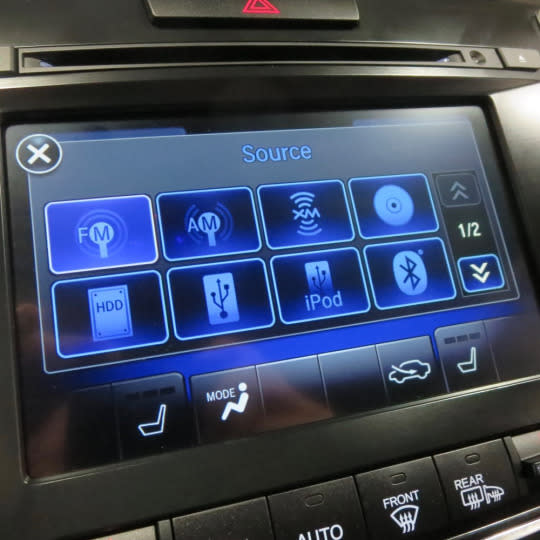When It Comes to Car Tech, the Cars Are Having a Hard Time Keeping Up With the Tech

Photo: Rob Pegoraro/Yahoo Tech
The promise is pretty simple: We want the smart parts of our phones to work in our cars, without getting distracted by the dumb bits or by having to touch the thing while we’re driving. But it’s still uncertain whether your next car will play nicely with your next phone — or, for that matter, whether car manufacturers will ever be able to keep up with the other personal technologies we use.
CarPlay vs. Android Auto
Both Apple’s CarPlay and Google’s Android Auto provide simplified dashboard access to your phone’s core car apps: navigation, music, calls, and texts (the last read and replied to via voice). They offer an interface like your phone’s, plus the ability for your phone’s other apps to show up in a consistent dashboard interface.
(My colleague Daniel Howley has reviewed both CarPlay and Android Auto; he pronounced the latter easier to use because it adjusts its display of apps and info “based on the time of day, your schedule, and your Google search history,” reducing the need for you to switch from one app to another manually.)
After years of going with proprietary systems, car manufacturers are finally gravitating to CarPlay and Android Auto — but they’re not doing so consistently. Audi, Buick, Cadillac, Chevy, Ford, GMC, Honda, Hyundai, Suzuki, VW, and Volvo all show up on both Apple’s and Google’s lists of compatible manufacturers. But quite a few others have picked one side or the other. For instance, Mercedes offers only CarPlay, while Kia sticks with Android Auto.
An analyst who’s been following this field for years doesn’t expect that to last in the long term. “No carmaker would do one and not the other,” says Roger Lanctot, associate director of Strategy Analytics’ automotive practice.
But in the near term it’s a mess, even within a given manufacturer’s lineup. For example, Honda’s Civic offers both Android Auto and CarPlay, but its larger CR-V includes neither. At Mercedes, you can get CarPlay in an E-class coupe but not in an E-class sedan.
And Android and iOS aren’t the only smartphone platforms in use. So far, the platform-independent MirrorLink system has drawn support only from VW in the States. And Toyota is betting on yet another option, an open-source standard called SmartDeviceLink, developed by a Ford subsidiary.
With the connectivity options of our next car so unclear, I can only hope my Prius keeps running as well as it has for as long as it can, to give the auto industry more time to make up its mind.
Telling the future is hard
Meanwhile, a tour of the Washington Auto Show’s exhibits last week reminded me that the auto industry simply has a hard time moving forward. Telling the future is hard, especially if you have to do it in 10- or 15-year chunks and need a few years to change your mind, the way car manufacturers still do when it comes to core dashboard components.
Consider the prominent iPod menu items I saw in a Lexus, a Volvo, and an Acura. Five years ago, supporting all the iPods still in use made sense. But now? Those screens must leave some younger buyers scratching their heads and wondering, “What’s an iPod?”
Or take the USB ports that are now practically ubiquitous in new cars (though, all too often, they’re buried inside a storage cubby between the passenger seats). At some point, if the forecasts of USB-C’s eventual triumph pan out, manufacturers will have to think seriously about switching to that newer, smaller, more versatile connector. But who among them will go first? And what will we do in the meantime?
Finally, consider the Chrysler 300 I examined on the show floor. At first its audio system seemed unremarkable. But then I realized that something was missing: the CD player. Years after aftermarket vendors started shipping car audio systems without that feature, some car manufacturers are beginning to do the same — or at a minimum, banishing the CD player to the center storage compartment or the glove box. Is it about time? Or is it too soon?
That’s the question car manufacturers must ask themselves constantly these days, as they try to keep up with rapidly evolving personal technologies. I’m glad I don’t have to make those decisions. I’m also glad that my only recent investment in car-phone connectivity was an $11 dashboard mount that holds my phone’s mapping apps up where I can see them.
Email Rob at rob@robpegoraro.com; follow him on Twitter at @robpegoraro.

